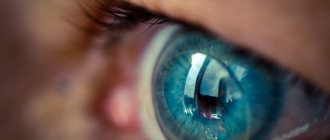Look at the photo of the cake. Do you see the red strawberries? Are you sure it's red?
Akiyoshi Kitaoka/ritsumei.ac.jp
But there is not a single scarlet or even pink pixel in the photo. This image is made using shades of blue, but we can still see that the berries are red. The artist used the same effect of changing lighting, which divided the world into two camps due to the color of the dress. And this is not the most delicious picture of the master of illusions. We share with you the most interesting things.
The ring turns white and black
Akiyoshi Kitaoka / ritsumei.ac.jp
What color is the ring in this picture? In fact, it consists of stripes of two colors - blue and yellow. But what happens if you break the picture in half?
Akiyoshi Kitaoka/ritsumei.ac.jp
What will happen is that the half of the ring will appear white on the left and black on the right.
Volume illusion
Photo: Casa Ceramica
There is a visible dent in the floor. Was it done by accident or intentionally? And if intentionally, then how and why?
Exposure
Exposure
If you look at This wavy floor is actually a mind‑boggling optical illusion that stops people from running in the hallway at the “dent” from any point of view, without being in front of the door, it will disappear.
Correct, here is the view back the other way @casaceramica pic.twitter.com/c6LaVIw1sW
— Duncan Cook (@DuncanCook10) September 22, 2017
The thing is that the manufacturers of finishing materials from the Casa Ceramica company prepared the tiles in a special way so that the shape of its individual fragments creates a “crater” effect. This floor is in one of the Casa Ceramica showrooms in Manchester and was designed to make people move more slowly and carefully through the corridors.
Mysterious rings
Akiyoshi Kitaoka / ritsumei.ac.jp
These rings deceive three times.
First, if you look at the picture, it looks like the inner ring is compressing while the outer ring is expanding. Second, try moving away from the screen and moving closer to it again. During movement, the rings rotate in opposite directions. Thirdly, these rings also change shades. If you look at the picture closely and focus your gaze on the center, the inner ring will appear redder than the outer one, and vice versa.
Researchers and doctors have revealed the secrets of optical illusions
The perception of illusion pictures apparently depends on the individual psychological characteristics of a person
Photo: EAST NEWS
SERPENT FORETTER
The most famous optical illusion is the Spinning Snakes . In 2005, it was first demonstrated to the public by Japanese psychology professor Akieshi Kitaoka . Since then, this and other "moving" figures have become hits on the Internet. Many argue that mysterious pictures are not only art and entertainment, but real health tests.
The most common interpretation is this: if the image in front of your eyes does not move, then you can rejoice - you have good mental health, a minimum of stress, and in general everything is fine (if suddenly you didn’t notice this without the pictures). When colored snakes are still moving, but slowly, you have accumulated fatigue, physical and mental, but the situation is not yet critical, and you can correct the situation by starting to get enough sleep (remember, for an adult from 18 to 65 years old, the average sleep norm is 7 - 9 hours, but someone individually may need 10 hours). If the snakes are actively moving, then the stress level is very high, there are already serious problems with the mental state - in a word, it’s time to see a doctor.
The most famous optical illusion is Spinning Snakes.
Skeptics, however, note that at different times of the day, after work or rest, and even more so after a glass of wine, the optical illusion looks different - it is unlikely that serious changes in health can happen so quickly. So what to believe and why are these mysterious pictures really needed?
EVERYTHING DEPENDS ON BRIGHTNESS AND SPEED
In the scientific community today there are two main versions of how the illusion of rotation works, Igor Utochkin, one of the leading Russian experts in the study of visual illusions, head of the scientific and educational laboratory of cognitive research at the Higher School of Economics, told KP. The first explanation is due to the fact that neurons (that is, nerve cells) in the visual cortex of our brain respond at different speeds to light of different brightness. Namely: the brighter the point or fragment of the picture we are looking at, the faster the corresponding neurons turn on and the brain processes the image. Darker and faded details cause neurons to respond a little slower.
Thanks to this difference in the speed of processing color and light, it is apparently possible to create the effect of rotating the picture. “Kitaoka used in his pattern a regular alternation of elements of different brightness, arranging them in a certain sequence: black-blue-white-yellow-black, etc.,” explains the expert. “As a rule, we see movement in the same direction.” That is, spots of different colors cause neural reactions in the visual cortex not simultaneously, but sequentially - just as happens when perceiving real movement.
Optical illusion "Disappearing blue dots"
WHEN THE EYES RUN
Another version is related to eye movement. Try looking intently at the center of one of the circles, and then move your gaze, trying to take in the whole picture. In the first case, the effect of pattern movement disappears, in the second it appears and intensifies, the faster you move your eyes or blink. “Since we are mobile, the picture before our eyes is changeable,” says Igor Utochkin.
- But when we look at other images, read a book and blink, there is no sensation of a running line - why?
“Our brain is designed in such a way that it usually distinguishes its own eye movements from the real movement of objects and, due to this, gives the command to perceive the picture as stable if it is actually stationary. But it is known that in such a recognition system failures are possible during micro-movements of the eyes - the brain may not notice them, and then the small displacements of the picture caused by these micro-movements are interpreted as movements of the pattern.
.
FATIGUE IS THE ENGINE OF PATTERNS
“I have never come across scientific works where researchers would prove the connection between the perception of visual illusions and any features of people’s health, their mental state, etc.,” the head of the scientific and educational laboratory of cognitive research shrugs. — At the same time, there is evidence that human eye movements change with general fatigue and visual overload. In particular, it becomes more difficult for people to fix their gaze on one point or detail; so-called drifts appear and intensify, that is, micro-sliding of the gaze from the original point. And this could theoretically enhance the sense of movement of the patterns in the picture.
Blue dots placed in the corners cannot be seen at the same time
By the way, when you are overtired, it begins to seem that not only the illusion images conceived for this purpose are moving. In any case, the author of this material, having delved into the topic and continuously reviewed several dozen similar pictures, suddenly discovered that the letters on the paper were already beginning to turn into a running line... Frightened, I quickly called a neurophysiologist.
TEMPERATE YOUR SOUL AND BODY
— Optical illusions are a multifaceted irritant that most likely affects certain areas of the cerebral cortex (visual zone, see above. - Author), but also the subcortex. Many of these processes have not yet been studied and remain a mystery,” says neurologist, neurophysiologist, candidate of medical sciences, corresponding member of the American Academy of Neurology Viktor Koss. “It is possible that the strength of the illusory movement may depend on cerebral blood flow - in the event of a circulatory disorder, the patterns will move faster. But this is just an assumption, there are no proven facts.
However, the leading role in the perception of illusions is played by... suggestion, says Dr. Koss. “If you don’t tell a person in advance that the patterns should rotate, but simply show a picture and ask what you see, then with a high probability he will not notice the movement,” the neurophysiologist assures. Also, in his opinion, those who generally feel good, have slept better, rested and have greater willpower are more likely to keep the picture stable and motionless.
“Floating Star” by Kaya Nao Next: https://uznayvse.ru/interesting-facts/samiye-krutiye-opticheskie-illuzii.html
- My conclusion is this: the more control over oneself and the world around one is lost, the more uncertainty, anxiety, chronic diseases, sleep disorders - the faster the snakes rotate. And the more collected a person is, the more trained, the more self-confident, the more tempered in soul and body, the less chance there is of seeing rotation where there is none, the doctor renders a verdict.
BY THE WAY
From dizziness to shortness of breath
“The perception of illusion pictures, apparently, depends on the individual psychological characteristics of a person, the structure of the brain, the production of neurotransmitters (that is, molecules through which signals are transmitted between nerve cells. - Author), says the head of the Center for Sleep Medicine at Moscow State University. Lomonosov, candidate of medical sciences Alexander Kalinkin. - Indeed, there is still a lot of unexplored stuff here. At the same time, it is known that optical illusions can cause discomfort and in this case act unfavorably from a medical point of view. Possible disruption of the autonomic nervous system, breathing regulation, dizziness, feelings of fear and anxiety. Therefore, I would advise not to get carried away with this. Watch 1 - 2 times and that's enough.
Japanese psychotherapist Yamamoto Hashima developed a test for the degree of fatigue: 1. The picture does not move - the person is stable 2. Moves moderately - psycho-emotional exhaustion 3. Moves actively - there are dangerous signs of psychosis, neurasthenia and depression
INSTEAD OF OUTPUT
The experts we interviewed agreed that visual illusions today cannot serve as tests of health status - doctors and scientists do not have proven data on the unambiguous connection of specific disorders in the body with the movement of patterns. At the same time, according to observations, the rotation of pictures often increases with physical fatigue, which we usually feel even without prompting.
“In general, the study of various illusions is an important part of research into how human perception, his senses and the brain work,” explains Igor Utochkin, head of the scientific and educational laboratory of cognitive research at the Higher School of Economics. “By learning how the curious glitches in illusions occur, we can learn something new about how perception works under normal conditions.”
Stereogram
Akiyoshi Kitaoka / ritsumei.ac.jp
And this is a stereogram. If you look at the drawing with the focus behind the image, you will see a circle in the middle. Try to get as close to the drawing as possible (almost touch your nose to the screen), and then slowly move away from it without moving your eyes. At some distance the circle should appear by itself.
twelve points
Image: Akiyoshi Kitaoka Facebook Page
Click on this image to open it in full and look for the 12 black dots. Try to see them all at once.
Exposure
Exposure
This illusion was first published by Jacques Ninio and Kent A. Stevens in 2000 in the academic journal Perception. It gained considerable popularity when psychology professor Akioshi Kitaoka at Ritsumeikan University in Kyoto shared it on Facebook.
The illusion is a variation of the famous “Hermann grid” created by German physiologist Ludimar Hermann in 1870. As a result of the imperfections of our retina, we see gray spots at the intersections of white lines where there are none. On the contrary, on the grid from Ninio and Stevens, points located in the area of peripheral vision are not visible.
The reason is that we do not have very good peripheral vision. Therefore, the brain thinks out those fragments to which we do not pay direct attention. We see one black dot, while the rest are out of focus. The brain does not attach importance to them and simply does not draw them.










